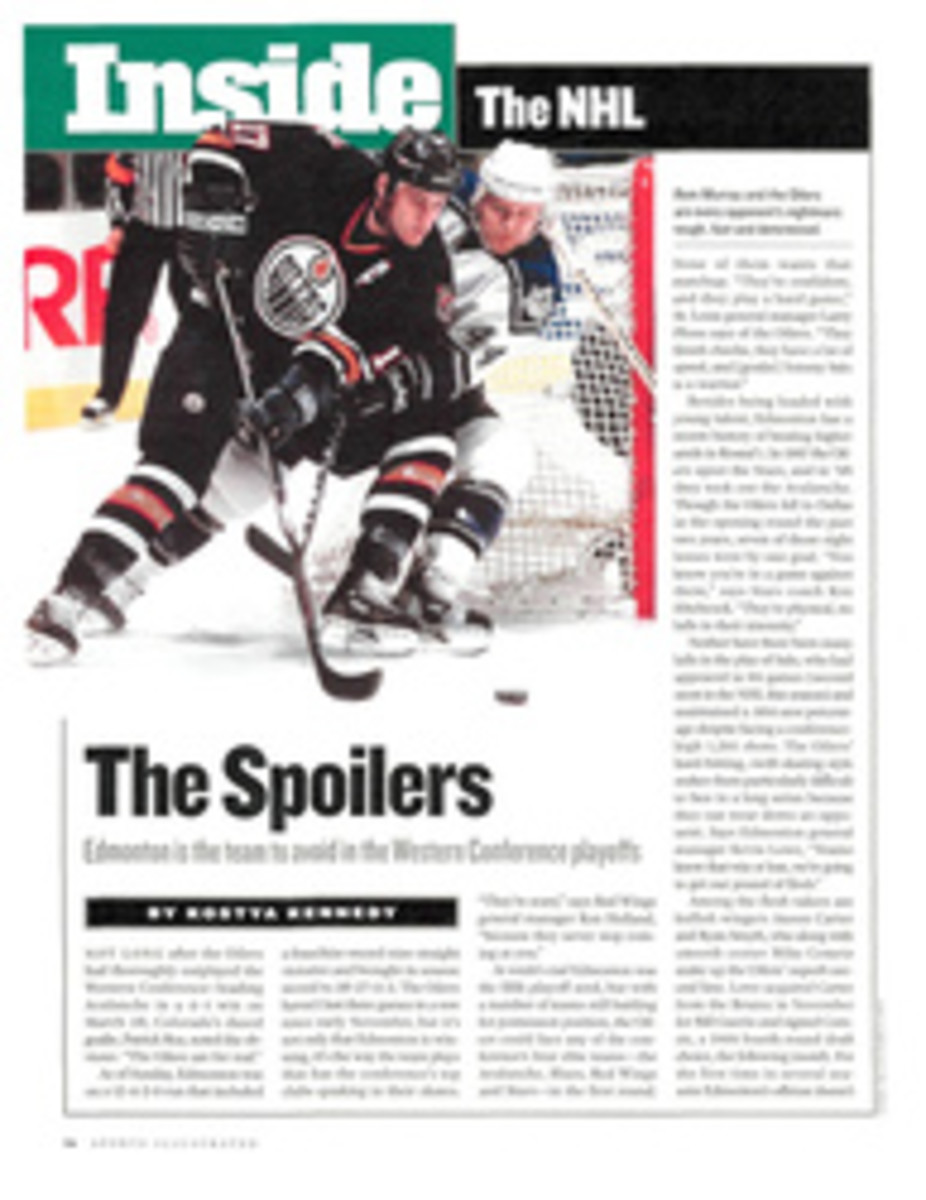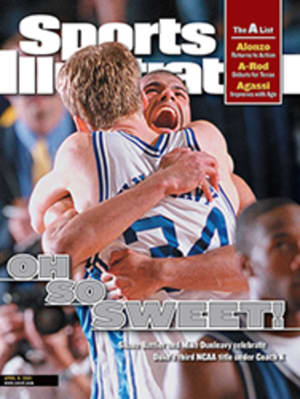
Mystery Man At 38, Capitals captain Adam Oates is on the verge of breaking numerous team and league records, but does anybody really know him?
Adam Oates is steering his black Mercedes through morning
traffic on the Beltway. Dressed in sneakers, jeans, a navy
sweatshirt and a yellow baseball cap, he drives much the way he
plays for the Washington Capitals, moving opportunistically but
unaggressively from lane to lane, occasionally making a smooth,
well-calculated pass. He holds a cup of coffee in his right
hand. "So did you hear that some guy gave $360 million to my
alma mater?" says Oates, who has a management degree from
Rensselaer Polytechnic Institute. "It's the largest donation
ever by an individual to a university, but get this...." Oates
pauses, sips his drink and thrusts out his sculpted jaw. He
checks the rearview mirror before continuing. "The guy gave the
money anonymously. So he sets this record, but nobody knows who
he is. Kind of mysterious."
Oates, who is the least recognized of the certain Hall of Famers
in the NHL today and who has set or is about to set numerous team
and NHL records, knows from mystery. How is it, for example, that
Oates, whom RPI coach Mike Adessa once affectionately called "a
stumpy, heavy-footed, poor-skating, no-shooting kid," is in his
16th NHL season and through Sunday had 961 career assists (ninth
alltime) and 1,277 career points (22nd)? How is it that at 38,
Oates, who's still a slow skater, was tied for the league lead
with 67 assists--more than any other player his age or older has
had in one season?
How could Oates, whom Washington coach Ron Wilson calls "the
smartest player I've ever seen," have gone undrafted? How does
Oates captain the Southeast Division-leading Capitals
(39-25-10-4) so effectively without raising his voice? Where does
he get the energy, at his age, to center Washington's top line,
play more than 21 minutes a night and dominate on face-offs? (He
had won 58.6% of his draws this year, fifth in the league.) How
does he do any of it with that sawed off, misshapen stick he
uses? And who, behind that aloof exterior, is Adam Oates, anyway?
"Whenever I go to a new team, a lot of guys ask me what it's like
to play with Adam Oates," says Phoenix Coyotes center Joe Juneau,
a teammate of Oates's with the Boston Bruins from 1991-92 through
'93-94 and in Washington from '96-97 through '98-99. "He's quiet
and people don't know much about him, but they see what a smart
player he is and they want to know what he's like. They really
want to know what's up with his sticks. Those things are the
ugliest in the league."
Oates runs through four dozen black Sher-Woods a month, and the
ones he tosses away after a single heft (about half, simply
because he doesn't like their feel) are spared his indelicate
touch. "There's no science to it," Oates says of how he shapes
his sticks. "I take each one, go to work on it and hope I can
make it feel how I want it to feel."
The way Oates goes to work on his stick would get Bob Vila
jazzed. The tools he uses include a handsaw, a jigsaw, a baby
hammer, a large hammer, a vise grip, a sander and a blowtorch.
First he chops off the toe of the blade to square it (a unique,
superstitious practice he began 10 years ago), then he sands the
base of the blade until it's flat ("When you're in the corner and
your stick is against the wall, you can still keep a lot of blade
on the ice," Oates explains), and then he saws, bends, twists,
massages and burns the blade until it feels the way he wants it
to. The process takes Oates about 15 minutes per stick.
"That's just another example of how he's always trying to do
whatever little thing he can to get an edge," says Wilson. "If
Adam notices something in a game, he adjusts right away. Even if
it's only how somebody is holding his stick. He takes the
information, processes it and puts it to use. The thing about
Adam is that he assimilates a lot of stuff at once. Most guys
might see one or two things, and the rest is a blur."
Oates's processing skills, as well as his sure hands, have made
him the second-best passer of his time and the player most
commonly compared with the best, Wayne Gretzky. Like other on-ice
visionaries, Oates changes speeds and uses subtle shifts in
movement and positioning to put defenders off balance. He likes
to bring the puck to just inside the offensive zone--a spot off
the left half-boards is a particular favorite--where he can dish
with either his forehand or backhand. The more options the
better, which is what makes Oates so dangerous when the Capitals
have a man advantage. (His 35 power-play assists also were
leading the league at week's end.)
"If you take away Oates, you pretty much take away everyone on
the ice," says Capitals center Trevor Linden, who had played
against Oates for 12 years before Washington acquired Linden from
the Montreal Canadiens last month. "It's hard because he's so
aware. You shut off one passing lane, and he finds another."
Oates has been working the angles and lines since his earliest
youth-league shifts and maintains an unshakable grasp of the
geometry around him, an understanding that he describes as
innate. What has developed over time is not so much his sense of
where to deliver the puck but how and when he'll put it on a
teammate's stick. "We're playing the Rangers last month, and I
make a move and I'm thinking, Wow, I wish I had the puck right
now," says Capitals wing Peter Bondra. "I look down, and Adam's
sending it right onto my tape, perfect as usual. Boom! I
one-timed it into the net."
Bondra is one of several NHL thoroughbreds to have been fed by
Oates, who is the only player to center three 50-goal scorers
(Bondra with 52 in 1997-98; Cam Neely with 50 for the '93-94
Bruins and Brett Hull with 86 in '90-91 and 72 in '89-90 for the
St. Louis Blues). Oates is also the only one to center two
players who scored 50 goals in 50 games (Neely and Hull, the
season he got 86). Oates, who has scored more than 20 goals only
five times in his career, has been the unheralded B side to one
'90s record after another. "He doesn't get as much publicity as
the goal scorers," says Hull, "but he loves to watch you put the
puck in the net. I never asked him why he didn't want to score
more himself; I was afraid he'd change his mind."
Oates developed his passing fancy while sitting around the dinner
table as a boy in Weston, Ont. Adam's father, David, grew up in
the northwest of England idolizing soccer star Stanley Matthews,
the Wizard of Dribble, who's widely regarded as the best English
footballer ever. David told Adam vivid tales of Matthews's feats,
all of which pointed up the fact that the soccer star made his
name as a divine passer who rarely scored. When Adam started
playing hockey and lacrosse, David implored him to "be like
Stanley--unselfish."
This year Oates has spread his generosity among a hodgepodge of
linemates, and his 80 points--already the second most ever for a
player 38 or older--constitute his highest total since he had 92
in 1995-96. Oates takes good care of himself (chicken-and-pasta
dinner and an early movie the night before games), but his
sustained excellence is attributable in part to Wilson, who
recognized his best player's needs and built around them. Last
year Wilson implemented an unorthodox forechecking scheme that
calls for Washington's centers to hang back while the wingers
attack the puck. This enables Oates to conserve energy, and plays
to his defensive strengths, which are founded more on positioning
than on physical aggressiveness. "All our centers do it, but we
devised the system for Adam," Wilson says. "If you get the most
out of him, you get the most out of your team. He's 38. I don't
want him to get tired chasing the puck and then be compromised
when he gets it."
Teammates treat Oates with similar deference, yet few know much
more about him than what they've read in the Capitals' media
guide: completed his degree from RPI in the 1991 off-season;
enjoys golf. A loner--"I don't know what he does in his spare
time," says his road roommate Jeff Halpern--Oates, who's single,
slips quietly in and out of practices, his mien serious and
intimidating. His cleft hunk of a jaw makes the pantheon of the
NHL's memorable facial features, a composite that includes, from
top to bottom: Mark Messier's domed forehead, Tie Domi's
monobrow, Ed Belfour's ice-blue eyes, Mike Ricci's crooked nose
and Ken Daneyko's fangs.
Oates doesn't slap bottoms or organize player lunches or invite
the new guys over for a beer. After games he ducks into the
shower before the media arrive in the dressing room, leaving the
spokesman's role to players such as goalie Olaf Kolzig. "I got
named captain before last season because of how I do things,"
says Oates. "I'm not going to change. I hope younger guys see
that I treat this game with a lot of care and attention."
Players can glean lasting lessons simply from Oates's manner in
practice, the way he executes each drill, no matter how routine,
with meticulousness. One of Oates's best friends is pro golfer
Mike Weir, and last summer Oates accompanied Weir to the British
Open, where they stayed together in a rented house near St.
Andrews. "We're in the driveway one day, just fooling around,
whacking balls into a field across the road," Weir recalls. "The
whole time Adam is saying things like, 'Weirsy, how's my grip?
How's my posture?'" Weir would give him a suggestion or two, and
then Oates would get quiet. He'd stare off for a few moments,
angling his face the way he does, and then he would slowly step
back in and address the ball. He hit it better and better as the
day went on.
COLOR PHOTO: PHOTOGRAPH BY MANUELLO PAGANELLI
COLOR PHOTO: LOU CAPOZZOLA Setup job Bondra (12) is one of three players who have scored 50 or more goals while teaming with Oates.
A Dish of Oates
ADAM OATES was tied for the NHL lead in assists through Sunday,
with 67, and his career 0.85 assists per game was fourth best in
history. Here are the alltime assists-per-game leaders (minimum
500 games).
PLAYER GAMES ASSISTS ASSISTS PER GAME
WAYNE GRETZKY 1,487 1,963 1.32
MARIO LEMIEUX* 784 914 1.16
BOBBY ORR 657 645 0.98
ADAM OATES* 1,125 961 0.85
PETER STASTNY 977 789 0.80
*Active

